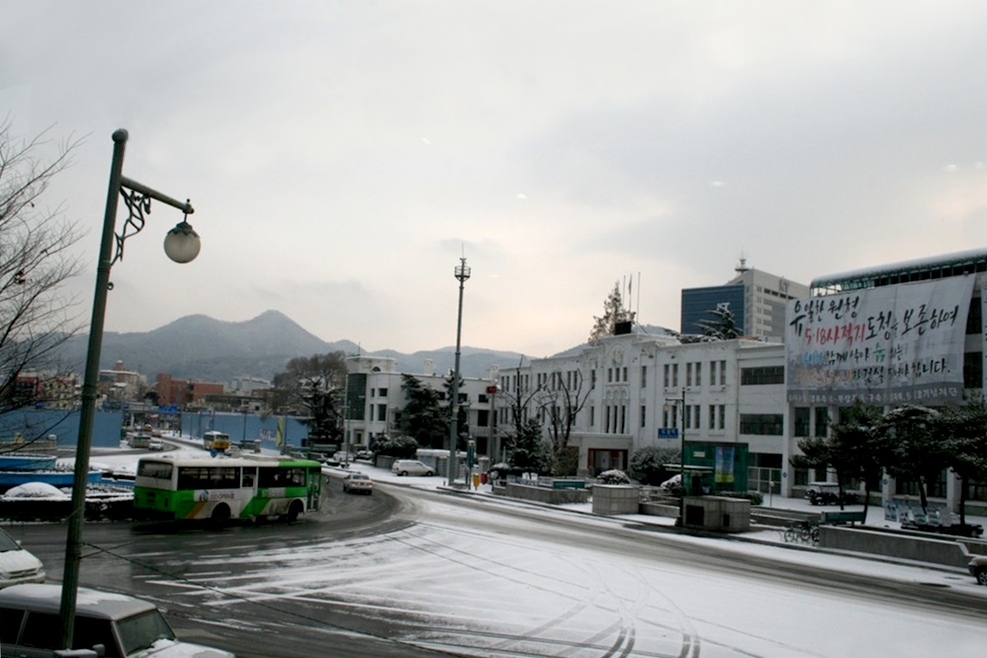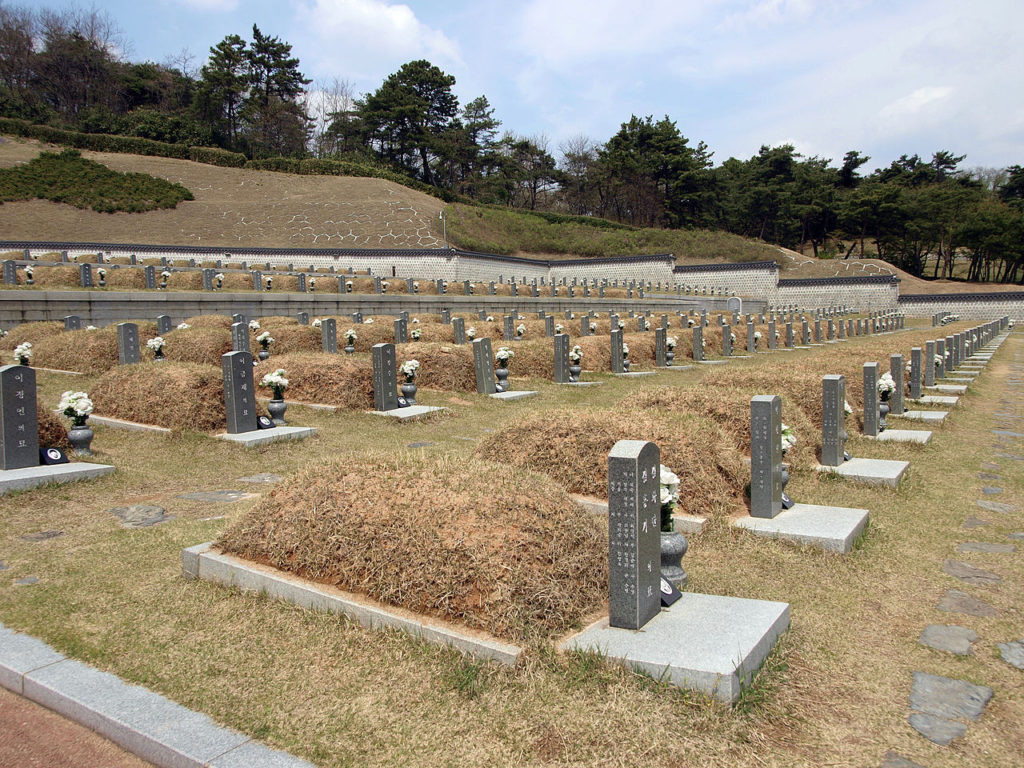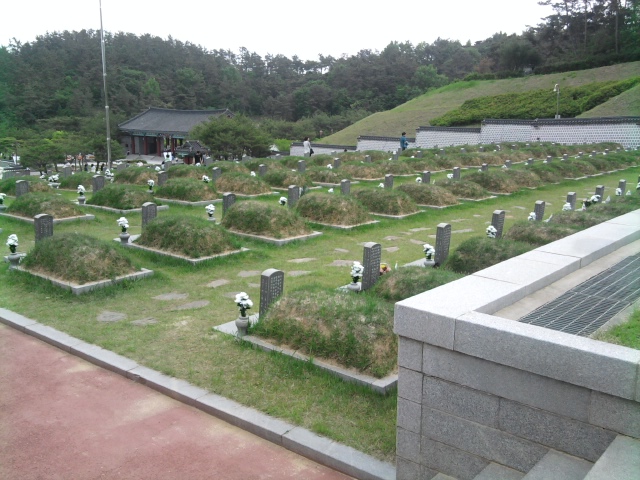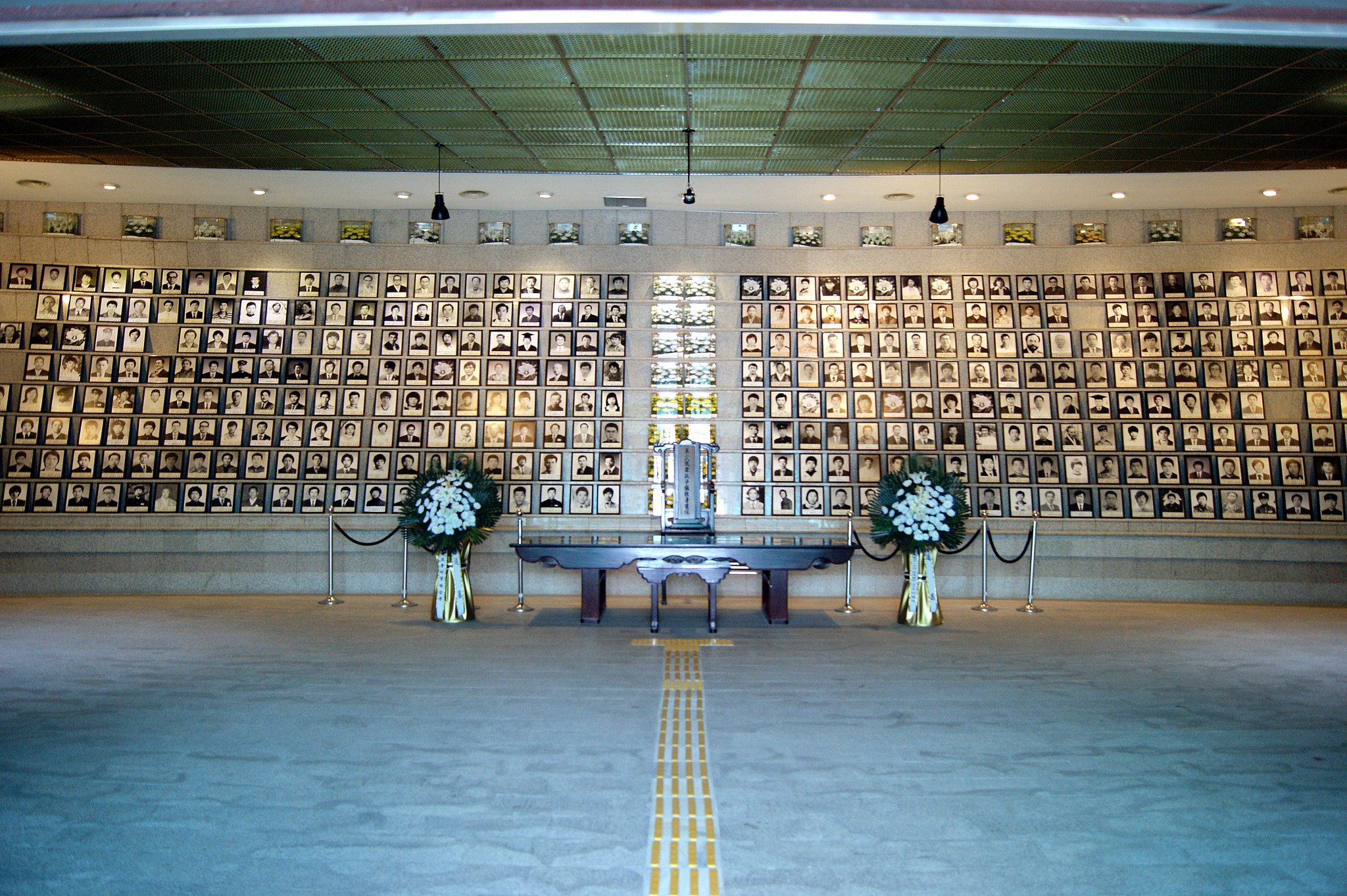MAY 18: Violence, Blood, Sorrow
Edited by Dr.David Shaffer.
At the mention of “May,” the first thought that still comes to mind for many residents of Gwangju is the “Gwangju Incident” (광주사태, Gwangju-satae), as it was called at the time (aka the Gwangju Uprising, aka May 18 Democratic Uprising, aka May 18 Gwangju Democratization Movement). But here at ground zero, it is most commonly referred to as O-il-pal
(오일팔, 5-1-8), May 18, the start of ten days of bloodshed and violence in the streets of Gwangju in the spring of 1980. This year, on the 40th anniversary of the event, the Gwangju News provides the following chronology of what took place. This incorporates in part an article carried in this magazine ten years ago (“May 18 [5.18] Gwangju Democratic Uprising,” May 2010) written by Prof. Shin Sang-soon (1922–2011) and is amply complemented with additional material. — Ed.
In the wake of President Park Chung-hee’s assassination on October 26, 1979, the collapse of the Yushin system was to soon follow. The Yushin system (aka “the October Reforms,” 시월유신) was a constitutional change instituted in October 1972 that made President Park’s despotic grip on power even tighter. In the six-month political and social vacuum that ensued following President Park’s death, the so-called New Military Faction gradually made its appearance, attempting to wield political power as Park’s Republican Party had done before. There was much student unrest during this time. On May 17, student activists met in the capital; 95 student leaders from 55 universities were detained by police. The Gwangju Democratic Uprising broke out on May 18, 1980, as an attempt to thwart the New Military Faction’s political ambitions. While the Uprising was, in one sense, a failed event in that it was brutally put down by the government’s martial law troops, it left an indelible mark in the minds of the citizens of Gwangju and Jeollanam-do. The following is a chronology of the main events, as they have been pieced together over the years, that shook Gwangju during those bloody ten days of May 1980.
Chronology of the Uprising
May 18, 1980 (Sunday): Emergency martial law is declared nationally at the stroke of midnight, and Kim Dae-jung and 25 other antigovernment political leaders are arrested. The 33rd and 35th Battalions of the 7th Airborne Brigade are deployed in the darkness to Chonnam National University and Chosun University, respectively, taking control of the two universities, where antigovernment demonstrations, often violent, had been taking place regularly throughout the spring. (The “airborne brigades” are also known as “special warfare units,” and more commonly as the army’s elite “Special Forces.”)
In the early morning hours of May 18, there are not many students on either campus. Some students in the libraries and research institutes are told by the martial law troops to go home because martial law decreed the closing of the universities for some time. This becomes the first day of the Gwangju Uprising. The school gates are blocked by the martial law troops (MLT), and students coming to school are told to disperse and go home, but they do not comply. At Chonnam National University, the number of students who cannot enter the school because of the closure increases by the hundreds, and students start shouting demonstration slogans: Lift the martial law! Down with Chun Doo-Hwan! (Chun Doo-Hwan was the military strongman in control of government, who later became president and created the Fifth Republic.)

The students, unable to enter the campus, turn around and take to the street, demonstrating. The MLT are also deployed at strategic locations throughout the city, and clashes ensue between them and the demonstrators. As Special Forces, the MLT dispatched to Gwangju were supposed to be well trained for dealing with demonstrators. But in Gwangju, in carrying out their duty, they overstep their bounds and mistreat the demonstrators with unnecessary brutality. Gwangju citizens are alarmed, agitated, and angry at witnessing the Special Forces’ harsh and merciless repression of the demonstrators. This is why citizens joined forces with the students. The midnight-to-4 curfew is expanded to begin at 9:00 p.m.
May 19, 1980: The Special Forces are reinforced by their 11th Brigade, who arrive at Gwangju Station, and suppression of demonstrations continues. This day takes the Uprising’s first casualty – a deaf young man, who did not seem to comprehend what was happening, was clubbed to death by the MLT. Citizens act out against the brutality of the MLT by setting two police stations ablaze, in Im-dong and Numun-dong. The number of gathering citizens increases and stone-throwing clashes occur. The MLT unit that had retreated to their Chosun University staging area is put back into action.

City officials and agency directors go into discussions and request that the MLT take a more lenient approach to crowd control. Protesters surround an MLT armored vehicle and are fired upon. A Chosun University Affiliated High School student becomes the first to be wounded by MLT gunfire. As this news spreads, more protesters take to the streets. Late afternoon rain quells the violence.
May 20, 1980: High schools are closed citywide. Additional deployment of the Special Forces’ 3rd Brigade increases the number of martial law forces in Gwangju to 3,400 troops. Confrontations between protesters and the MLT continue and escalate. About 30 male and female protesters are captured, forced to strip down to their underwear, and severely beaten.
After witnessing the atrocities of the MLT, drivers of about 200 taxis, city buses, and trucks congregate at Mudeung Stadium and create a procession of vehicles that rolls down Gwangju’s main thoroughfare, Geumnam-ro. With horns blaring and headlights beaming, and protesters filling the vehicles, the procession heads towards the Provincial Office. In an effort to stop the caravan, the MLT pull some of these “drivers for democracy” from their vehicles and beat them. The procession is stopped by police and the MLT as it turns towards the Labor Office (to the immediate left of the Provincial Office); a one-hour standoff ensues. In an attempt to break through the roadblock at the start of curfew, buses of protesters charge the police line, killing four officers.
Outraged by the lack of media reports on the brutality of the MLT, protesters set fire to the MBC building (Munhwa Broadcasting Corporation building, near the Labor Office) at 10:00 p.m. Meanwhile, at approximately 11:00 p.m. at the Gwangju Station plaza, the MLT open fire on the unarmed civilians protesting against the bloodshed. Many are wounded and killed, bringing some protesters to the conclusion that they needed to arm themselves for self-defense.
May 21, 1980: This is Buddha’s birthday, a national holiday and a normally tranquil day. After midnight, confrontations between the MLT and crowds estimated of up to 20,000 continue in the Labor Office area. Around 2:00 a.m., telephone lines are cut for all out-of-city service. At the Gwangju Station plaza, two corpses from the previous day’s incident are put into carts and paraded up Geumnam-ro until they are stopped by police and the MLT at the Catholic Center. Hearing of this, thousands of protesters are readied for further action. At 4:30 a.m., the KBS broadcasting station (then located adjacent to Sajik Park) is set ablaze. Communications with the outside world are now cut off. (There were no cell phones or Internet at the time.)
At 8:00 a.m., protesters clash with the MLT of the 20th Division at the entrance on the Gwangju Industrial Park (which was then in Nongseong-dong, the edge of town at the time). The MLT are issued live ammunition and are rotated to the front lines. Protesters take control of the Provincial Office building. The Gwangju Tax Office, an old, Japanese-style wood-frame building, is set ablaze and burns to the ground (located just down the street from the Labor Office). Near noon, a large helicopter lands in the plaza in front of the Provincial Office for a short period of time. At 1:00 p.m., an armored vehicle taken by protesters from the Asia Motors factory makes an unexpected appearance at the plaza (Asia Motors was a government contractor for military equipment). With the national anthem blaring from Provincial Office loudspeakers, the MLT open fire. Receiving concentrated fire, protesting youths on Geumnam-ro continuously fall.
Soon afterwards, the provincial governor’s call for protesters to disband is broadcast from a police helicopter (at the time, Gwangju was a part of the province). Protesters take control of several dozen military trucks and armored vehicles from the Asia Motors factory. Meanwhile, with the assistance of coal miners, other protesters take possession of TNT from an ammunition storage area in Jiwon-dong. Positioning themselves on the rooftops of the main downtown buildings, the MLT fire on protesters below. Groups of protesters arm themselves with firearms acquired from armories in Hwasun. Other protesters raid police station stores.
Students install two machine guns on the rooftop of the Chonnam University Hospital (located near Chosun University) for use against the MLT. Confronted with this unexpected turn of events, the MLT make a strategic withdrawal to the nearby Chosun University campus and the outskirts of town elsewhere to avoid further clashes with the now-armed protesters, who become known as the “Citizens Army” (Simin-gun, 시민군), and await MLT reinforcements. Thus ends the heaviest day of violence.
MLT are issued live ammunition and are rotated to the front lines. Protesters take control of the Provincial Office Building. The Gwangju Tax Office, an old, Japanese-style wood-frame building is set ablaze and burns to the ground (located just down the street from the Labor Office). Near noon, a large helicopter lands in the plaza in front of the Provincial Office for a short period of time. At 1 p.m., an armored vehicle taken by protesters from the Asia Motors factory makes an unexpected appearance at the plaza (Asia Motors was a government contractor for military equipment). With the national anthem blaring from Provincial Office loudspeakers, the MLT open fire. Receiving concentrated fire, protesting youths on Geumnam-ro continuously fall.

Soon afterwards, the provincial governor’s call for protesters to disband is broadcast from a police helicopter (at the time, Gwangju was a part of the province). Protesters take control of several dozen military trucks and armored vehicles from the Asia Motors factory. Meanwhile, with the assistance of coal miners, other protesters take possession of TNT from an ammunition storage area in Jiwon-dong. Positioning themselves on the rooftops of the main downtown buildings, MLT fire on protesters below. Groups of protesters arm with firearms acquired from armories in Hwasun. Other protesters raid police station stores. Students install two machine guns on the rooftop of the Chonnam University Hospital (located near Chosun University) for use against the MLT. Confronted with this unexpected turn of events, the MLT make a strategic withdrawal to the nearby Chosun University campus and the outskirts of town elsewhere to avoid further clashes with the now-armed protesters, who become known as the “Citizens Army” (Simin-gun, 시민군), and await MLT reinforcements. Thus ends the heaviest day of violence.
May 22, 1980: Around 9:00 a.m., citizens assemble in the Provincial Office area and down Geumnam-ro. A military helicopter overhead scatters fliers “To the Rebels,” urging them to turn in their weapons. Meanwhile, a call for blood donations goes out from the Red Cross Hospital’s bloodmobile and a protesters’ van traveling around town. From the rooftop of the Provincial Office, the national flag, accompanied by a black ribbon, is hoisted to half-staff.
Mindful of the unusual turn of events, a Citizens Settlement Committee composed of about 20 religious leaders, lawyers, and professors is formed to manage this urgent situation. In the early afternoon, eight representatives of the committee visit the MLT headquarters at the Sangmu-dae military base, presenting their seven demands, which included the release of arrested citizens, compensation for victims, and prohibition of retaliation in exchange for disarming of the protestors.
In mid-afternoon, 18 corpses arrive at the Provincial Office plaza and a citizens’ mass meeting is held. Later, a representative of the Citizens Settlement Committee reports the results of their visit to Sangmu-dae. Another 23 bodies arrive at the plaza. In the evening, the rest of Korea gets its first news from the government about the situation in Gwangju: The new premier states that “there is an absence of order in Gwangju.” On this day, protests spread to four other cities in the province: Mokpo, Naju, Hwasun, and Haenam.

May 23, 1980: In the uneasy quiet that hangs over the city, the MLT block all civilian movement into and out of the city. In the morning, students and citizens begin cleaning up the debris in the Geumnam-ro area. By mid-morning, about 50,000 citizens congregate at the Provincial Office plaza. The Students Settlement Committee begins retrieving arms from protesters, and lists of the names of the dead are posted around the plaza area.
Though there is a lull in the fighting this day, the MLT in Jinwol-dong, Junam Village, open fire on a mini-bus trying to break out of the city. Of the 18 passengers, 17 are killed, two of whom are dragged to a nearby hilly area, beaten, and hidden in a shallow grave. Back at the Provincial Office plaza, an all-citizens’ rally is held to discuss the leaflet air-dropped around the city urging the citizenry to put down their weapons. In the evening, the first 33 prisoners to be released by the MLT arrive at the Provincial Office plaza.
May 24, 1980: The MLT spot a group of boys swimming in the Wonjae village reservoir and fire on them. A first-year middle school student is hit in the head and dies. A martial law unit withdrawing to Songam-dong exchanges fire with other troops concealed in the area, resulting in numerous troops killed and wounded. In the anger that is vented afterwards, several innocent residents of the neighborhood are also killed. Later in the afternoon, the second citizens’ mass rally is held at the Provincial Office plaza, at which the city is declared to now be “liberated.”
May 25, 1980: Cardinal Stephen Kim Sou-hwan sends a message and ten million won to aid the Gwangju resistance. The MLT, forced to withdraw from the city, form a blockade of the city and kill civilians attempting to cross the blockade, including residents of the province coming to the aid of the protesters. The third citizens’ mass rally is held in mid-afternoon. Later in the day, Father Kim Seong-yong and other prominent pro-democracy activists adopt four articles for control and management. In the evening, the Students Settlement Committee discusses measures for food distribution, debris removal, and crime prevention.
Negotiations with the MLT have reached a deadlock as the MLT insist that the protestors disarm and surrender. There is disagreement between the students’ and citizens’ settlement committees as to whether to comply. Eventually, those in favor of continuing the resistance win out.
May 26, 1980: At dawn, the MLT advance from the Hwajeong-dong area to the Rural Development Office in Nongseong-dong, poised to re-enter the city; protesters lie down on the street to thwart their advance. News of an imminent MLT assault on the city spreads; the Citizens Settlement Committee resolves to proceed with a “March of Death” to prevent the MLT from entering the city center. This is followed by a mid-morning all-citizens’ rally for the preservation of democracy. Armed protesters begin to gather in the Provincial Office area to make their final stand there.

In the afternoon, the Students Settlement Committee urges the city mayor to provide them with daily necessities. A fifth all-citizens’ rally is also held. Later in the afternoon, the Students Settlement Committee briefs the foreign reporters who have been able to reach the city on the present situation. At 7:00 p.m., the Citizens Army announces that “There is a high probability that the martial law forces will invade tonight” and tell young students and females to return to their homes. At midnight, all intra-city telephone lines go dead.
May 27, 1980: At 3:00 a.m., the MLT begin to enter the downtown area with tanks. From the Provincial Office area, a female voice can be heard broadcasting, “The martial law troops are gaining the upper hand. Gwangju citizens, please help us!” The MLT secure the major buildings around the Provincial Office building. By 4:00 a.m., the MLT have the Provincial Office area encircled, as dozens of armed protesters have decided to make their last stand from inside. The protesters are urged to give up resistance and surrender. Clashes break out on Geumnam-ro and sporadic gunfire comes from within the Provincial Office building. At 4:10 a.m., the MLT begin their final assault on the building, as the armed protestors inside did not put down their weapons and surrender. It is at this time also that military helicopters fire over 200 rounds into the tenth-floor offices of Chonil Broadcasting (VOC) in the Chonil Building (just across the plaza from the Provincial Office). One hour later, the MLT take control of the Provincial Office building; the city in its entirety is now under MLT control. The MLT announce that citizens are not to come out into the streets. There is a massive movement of the 20,000 troops from the 20th Infantry Division into the downtown area and other parts of the city. Control of the area is transferred to them from the Special Forces who carried out the assault on the Provincial Office. It is 7:00 a.m.; the ten-day, bloody and tragic Gwangju Uprising has ended.

The Dead and Wounded
The figures for the number of dead and wounded in the Gwangju Uprising have been challenged from the beginning when the Martial Law Command announced that 144 civilians died, along with 23 soldiers and 4 policemen. Figures for those wounded were set at over a hundred for each. Many of the MLT casualties occurred in the Songam-dong friendly-fire incident.
Seventy-six civilians are still missing, according to reports from the May 18 Bereaved Families Association. They are presumed dead, and it is often suggested that they may have been killed and concealed in shallow graves by the MLT. However, the records for deaths in Gwangju during the month of May 1980 were over 2,000 above the monthly average, highly suggesting that the spike was due in large part to the violence in the city. Figures quoted by the foreign press and by those within Korea critical of the government’s officially announced figures often put the actual death toll at somewhere between 1,000 and 2,000.
Interment
The civilians who were lost in the Gwangju Uprising were taken to the Mangwol-dong Public Cemetery for burial. Some of the bodies were brought on trucks, some on carts, and some even on garbage trucks. A special section of the expansive cemetery was set aside for the creation of the May 18th Cemetery and the interment of those who lost their lives in the Uprising.
As Korea democratized, the national government approved in 1994 the creation of a new “May 18th National Cemetery” also in the Mangwol-dong area. Bodies from the original cemetery were moved to the new location and the new national cemetery was opened in a May 18 commemorative ceremony in 1997. There are now over 480 buried at the cemetery with the capacity to accommodate 300 more. The May 18th National Cemetery includes a large memorial hall with exhibitions, a portrait enshrinement tower, an additional exhibition hall, numerous statues and sculptures, and three memorial gateways.
Last December, over 40 unidentified bodies were discovered at the former Gwangju Prison in Munheung-dong while excavating a known graveyard there (Gwangju News, February 2020). Holes, believed to be bullet holes, were found in skeletal remains, suggesting that they are victims of the Gwangju Uprising, something long rumored in the neighborhood. The remains are now being examined for identification. If confirmed to be victims of the Uprising, there will be a place for them in the May 18th National Cemetery.

The Significance of the Uprising
The uprising started as a small-scale demonstration by students in front of a school gate, but the Special Forces’ countermeasures were unnecessarily harsh and brutal, angering and enraging the Gwangju citizenry. Even though the citizens managed to arm themselves for self-defense, they were of course no match for the well-trained regular army and its Special Forces. The civilians were like a cornered mouse biting a cat. During those ten days, the maintenance of law and order was in the hands of citizen groups, but there were no reported incidents of looting or thievery. No crime was reported. Gwangju citizens became one unit of solidarity, a fact in which Gwangju citizens take great pride.
The government, for its part, originally labeled the affair a “rebellion.” Over 1,300 people were arrested, over 400 indicted, and over a dozen sentenced to life imprisonment or death. It was also made illegal to “spread false rumors” about the Gwangju Uprising by deviating from the government’s official version of the casualties.
With a change of governments and the democratization of Korea, attitudes and actions also changed. May 18 was proclaimed an official memorial day in 1997. A ceremony to commemorate the 40th anniversary of the Gwangju Uprising and honor those who lost their lives in defense of the city is to be held at the May 18th National Cemetery this May 18.
Sources
– 5.18 민주화운동기록관 [5.18 Archives]. (n.d.). 광주 시민의 함성 [Gwangju Citizens’ Outcry]. http://www.518archives. go.kr/?PID=004
– Cheon, J. (2019, December 20). 옛 광주교도소 발굴 유골에 구멍 뚫린 흔적 발견 [Hole discovered in skeletal remains excavated at former Gwangju prison]. -Yonhap News. https://www.yna.co.kr/ view/AKR20191220156851054
– Gwangju Uprising. (2020, February 20). In Wikipedia. http://libcom. org/history/1980-the-kwangju-uprising
– Katsiaficas, G. (2006, September 19). The Gwangju uprising, 1980. libcom.org. http://libcom.org/history/1980-the-kwangju-uprising
– May 18th National Cemetery. (2019, December 3). In Wikipedia.
https://en.wikipedia.org/wiki/May_18th_National_Cemetery
– The May 18 Memorial Foundation. (n.d.). 5.18 타임라인 [May 18 Timeline]. http://www.518.org/sub.php?PID=010102
– The May 18 Memorial Foundation. (n.d.). The May 18 Democratic Uprising. http://eng.518.org/sub.php?PID=0201
THE EDITOR / CONTRIBUTOR
David Shaffer is a resident of Gwangju and has been since the early 1970s. In May 1980, he was a young professor at Chosun University and a newlywed living near the university. Many of the events of that period remain as vivid impressions etched into the memory 40 years later. Dr. Shaffer is now board chair at the Gwangju International Center and editor-in-chief of the Gwangju News.







